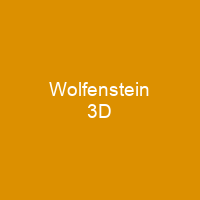Wolfenstein 3D is a first-person shooter video game developed by id Software and published by Apogee Software and FormGen. Originally released on May 5, 1992 for DOS, it was inspired by the 1981 Muse Software video game Castle Wolfenstein, and is the third installment in the Wolfenstein series. The player assumes the role of Allied spy William. J. Blazkowicz during World War II as he escapes from the Nazi German prison CastleWolfenstein.
About Wolfenstein 3D in brief

The game was a critical and commercial success and widely considered to be one of the greatest video games ever made. It was released in two sets of three episodes under the shareware model, in which the first episode is released for free to drive interest in paying for the rest. An additional episode, Spear of Destiny, was released as a stand-alone retail title through Form Gen. FormGen released a pack of over 800 fan-created levels. To finish a level, the players must traverse through the area to reach an elevator, and can gain points by finding extra-life tokens or by earning enough points. Points are scored by killing all enemies in a level and can also be scored by collecting all the treasure scattered throughout the level under a par par. Secret areas can be found in hidden rooms that slide back when triggered when a certain wall or room is completed, or by activating certain wall tiles in certain rooms. The final level focuses on a boss fight with a particularly difficult enemy, with the final level focusing on aparticularly difficult enemy. The players can find weapons and ammunition placed in the levels or can collect them from dead enemies; weapons include a knife, a pistol, a submachine gun, and a rapid-fire chain gun. If the player’s health falls to zero, they lose one life and start the level over with a knife and eight bullets. The player can only save at one point in any of the three sets of episodes.
You want to know more about Wolfenstein 3D?
This page is based on the article Wolfenstein 3D published in Wikipedia (as of Dec. 07, 2020) and was automatically summarized using artificial intelligence.






